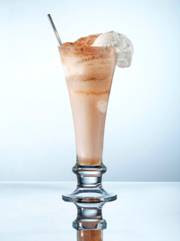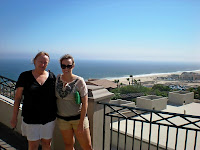
Alessandro Lunardi has been with the Frescobaldi family for over 20 years and is well versed in every aspect of wine from viticulture to marketing. I had the opportunity to chat with Alessandro following an evening he hosted recently, “Everyday Wines From the Marchesi de’ Frescobaldi family."
Alessandro opened up about this historic family, their fabulous wines and even offered some of his own tips:
Tell us about the history of Frescobaldi wine.
The Frescobaldi Family has been making wines for 700 years from spectacular estates scattered in the Tuscan countryside. They are passionate about their vineyards and define themselves as “stewards of the land”, for this reason they make wines with a strong sense of place. They have been constant innovators, and have often challenged the status quo from when they first planted Chardonnay and Pinot Noir in their Castello di Pomino Estate, to the creation of Mormoreto, a Bordeaux blend wine, made since 1983 at the Nipozzano estate. The guiding philosophy for the Frescobaldi's is getting the most from the land. Sometimes that means adhering to traditions and sometimes that means new ways of looking at their estates and different varieties. The Frescobaldi's have always been strong advocates of the Tuscan viticultural tradition they belong to, vigorously advocating that Sangiovese can make world class wine when planted in the right place.
The Frescobaldi Family has been making wines for 700 years from spectacular estates scattered in the Tuscan countryside. They are passionate about their vineyards and define themselves as “stewards of the land”, for this reason they make wines with a strong sense of place. They have been constant innovators, and have often challenged the status quo from when they first planted Chardonnay and Pinot Noir in their Castello di Pomino Estate, to the creation of Mormoreto, a Bordeaux blend wine, made since 1983 at the Nipozzano estate. The guiding philosophy for the Frescobaldi's is getting the most from the land. Sometimes that means adhering to traditions and sometimes that means new ways of looking at their estates and different varieties. The Frescobaldi's have always been strong advocates of the Tuscan viticultural tradition they belong to, vigorously advocating that Sangiovese can make world class wine when planted in the right place.
Why is working at Frescobaldi so important to you?
Because Frescobaldi is a great company and an exceptional family where people represent “the” core value. When you work at Frescobaldi you are embraced in the family values and ethics, you share the passion and dedication of everybody, and are made part of the magic and success of the company. In addition this is a very well managed company, with clear strategies, a managerial structure that is second to none, and excellent support for those like me who are in the “front line”.
Because Frescobaldi is a great company and an exceptional family where people represent “the” core value. When you work at Frescobaldi you are embraced in the family values and ethics, you share the passion and dedication of everybody, and are made part of the magic and success of the company. In addition this is a very well managed company, with clear strategies, a managerial structure that is second to none, and excellent support for those like me who are in the “front line”.
Which is your favorite Frescobaldi wine?
It’s hard because I like them all … each has a soft spot in my heart. But if I have to pick two wines stand out: Castelgiocondo Brunello di Montalcino is for me the essence of great Sangiovese, made from vineyards on volcanic soils in the South West of Montalcino, it epitomizes the great elegance and harmony that belongs to everything in Tuscany; but above all I adore Mormoreto, a wine made of Cabernet Sauvignon, Merlot and Cabernet Franc, that has the classic style, aristocratic complexity, and gorgeous structure of the greatest wines of the world. And despite its French appearance Mormoreto breaths of Tuscany from the moment you pour it in a glass. And lastly Mormoreto frames the courage of the Frescobaldi family: when it was not fashionable at all, they decided to plant those unfamiliar varieties because they were the best to express that vineyard site … and this dedication to the place just amazes me.
Can you tell us a bit more about your Frescobaldi wine app? Any plans for future apps?
It is a new tool that will allow the consumers to enjoy wines. We are looking at expanding our reach to the consumer, especially the younger generations, providing as many tools as necessary to understand our wines and the places where they come from … so, stay tuned, there will be more coming!
Prior to joining Frescobaldi, you were a Wine Education Manager for Robert Mondavi - what is your biggest advice to individuals who are just starting to learn about wine?
The single most important advice to those who are starting to learn about wine is “trust your palate!” There is so much intimidation in our industry, with so many wines experts, and so much information that it may be frustrating to many people. I believe when it comes to wine nobody is wrong, it’s a question of pleasure, and each palate is different, so concentrate in understanding and appreciating what you drink, do some homework, and little by little refine you palate, but stick to it! Don’t drink a wine just because it received a high rating from a critic. This is how I started … and it worked.
Any advice for the more seasoned enthusiast, too?
I may just suggest to always drink wine with food, and evaluate how they complement the meal. I hear so many people talking about the extremes of wine, concentration, power, richness, and I am afraid we often forget that the ultimate experience is to have balanced wines that dance on your table with right meal.
I may just suggest to always drink wine with food, and evaluate how they complement the meal. I hear so many people talking about the extremes of wine, concentration, power, richness, and I am afraid we often forget that the ultimate experience is to have balanced wines that dance on your table with right meal.
Where do you see the future of wine extending to?
I think in the future, wine will be linked more closely to the place where it comes from, beyond the labels or the catchy fantasy names. I believe the younger generations, who are much more informed, are interested in discovering the stories and the places behind a wine, and are interested in experimenting. I also believe environmental sustainability in the vineyards and in the winemaking will be a strong trend. I continue to see more women in wine, at all levels, winemakers, sommeliers, sales reps, and customers. I am amazed by their acute sensitivity to wine and how accurate they are in their descriptions. I think women have one more 'gear,' a greater sensitivity for identifying and describing the nuances of fine wine.
If the world were to end tomorrow, what food and wine pairing would be your last supper?
Ahhh! Tricky question! I am from Tuscany and love our wines, but if had to pick the last bottle of my life it would be a Grand Cru Burgundy from a great vintage of the past, with the divine foie gras stuffed quail my sister-in-law, Sophie, makes.
Ahhh! Tricky question! I am from Tuscany and love our wines, but if had to pick the last bottle of my life it would be a Grand Cru Burgundy from a great vintage of the past, with the divine foie gras stuffed quail my sister-in-law, Sophie, makes.
Alessandro was kind enough to offer me several new Frescobaldi wines to try at my leisure, so be sure to check back each day this week to discover vicariously through my sipping!











